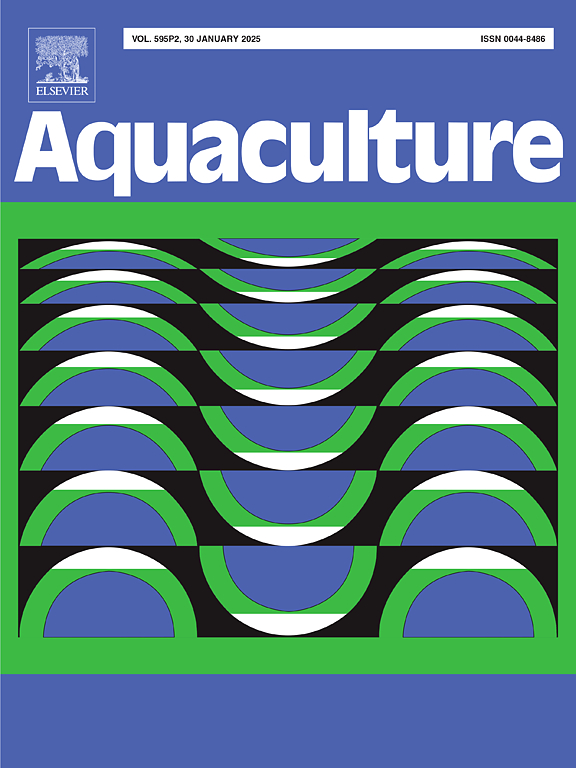饲料发酵稻壳对尼罗罗非鱼生长性能、饲料效率、肠道组织形态指标、抗氧化状态及相关基因的影响
IF 3.9
1区 农林科学
Q1 FISHERIES
引用次数: 0
摘要
为了实现水产饲料业的可持续性,有人建议发酵植物副产品,包括稻壳(RH)。因此,使用加工过的农副产品是以低成本生产高质量饲料的可行而有效的解决方案。本研究在尼罗罗非鱼日粮中添加了发酵稻壳(FRH),添加量分别为 50、100、150 和 200 克/千克。此外,还提供了不含发酵稻壳的日粮(Ctrl)和不含发酵稻壳的日粮(NFRH)。270 尾尼罗罗非鱼幼鱼(平均初始体重为 19.54 ± 0.32 克/尾)被分为六组(三重复),六种试验日粮(NFRH、Ctrl、FRH5、FRH10、FRH15 和 FRH20)分别喂养 75 天。结果表明,与饲喂 NFRH 相比,饲喂 FRH 可提高最终体重(FBW)、增重、特定生长率(SGR)和蛋白质效率比,但饲料转化率明显降低(P < 0.05)。回归分析表明,日粮中添加 137.5 至 157 克/千克的 FRH 可使鱼类达到最大的 FBW 和 SGR(P < 0.05)。日粮中添加 FRH15 的鱼的胴体粗蛋白含量高于日粮中添加 NFRH 的鱼(P < 0.05)。饵料 NFRH 引发了肠绒毛的卡他性炎症和肠上皮顶端退化部分的分离。有趣的是,FRH 浓度升高会显著改善前段绒毛高度和鹅口疮细胞水平,增加中段和后段肠绒毛的分枝,尤其是在较高浓度(FRH15 和 FRH20)时(P < 0.05)。此外,消化酶(淀粉酶、脂肪酶和蛋白酶)的活性在喂食 FRH 的鱼类中呈剂量依赖性提高(P < 0.05)。饲喂 FRH15 和 FRH20 的鱼的 GHR1、IGF-1、FABP 和 CD36 基因的相对表达量明显高于 Ctrl 和 NFRH 日粮(P < 0.05)。此外,抗氧化相关基因(CAT、SOD 和 GPX)的 mRNA 表达水平在 FRH20 日粮中出现上调(P < 0.05)。综上所述,在尼罗罗非鱼饲料中添加 FRH 200 g/kg,不会影响其生长性能、饲料消化、肠道健康和抗氧化状态。本文章由计算机程序翻译,如有差异,请以英文原文为准。
The growth performance, feed efficiency, intestinal histo-morphological indices, antioxidat ive status, and related genes of Nile tilapia (Oreochromis niloticus) fed fermented rice hulls
Fermentation of plant-originated by-products, including rice hulls (RH), is suggested for the sustainability of the aquafeed industry. Hence, using processed agriculture by-products can be a feasible and effective solution to produce high feed quality at low cost. In this study, fermented rice hulls (FRH) were included in Nile tilapia diets at 50, 100, 150, and 200 g/kg. Further, fish offered FRH-free diet (Ctrl) and non-fermented rice hulls (NFRH). 270 Nile tilapia juveniles with an average initial weight of 19.54 ± 0.32 g/fish were distributed in six groups (triplicates), and the six respective test diets (NFRH, Ctrl, FRH5, FRH10, FRH15, and FRH20) were offered for 75 days. The results showed that final body weight (FBW), weight gain, specific growth rate (SGR), and protein efficiency ratio were increased while the feed conversion ratio was markedly reduced (P < 0.05) by dietary FRH compared to fish-fed NFRH. The regression analysis showed that the maximum FBW and SGR can be reached by dietary inclusion of FRH at 137.5 to 157 g/kg (P < 0.05). The fish-fed with dietary FRH15 showed higher carcass crude protein content than fish-fed NFRH (P < 0.05). Dietary NFRH triggered catarrhal inflammation of the intestinal villi and separation of the degenerated apical part of the intestinal epithelium. Interestingly, the elevated concentration of FRH caused prominent improvement at the level of villous height and goblet cells in the anterior part and increased branching of intestinal villi in the middle and posterior segments, particularly at the higher levels (FRH15 and FRH20) (P < 0.05). Further, activities of digestive enzymes (amylase, lipase, and protease) showed improved values in fish-fed FRH in a dose-dependent manner (P < 0.05). The relative expression of GHR1, IGF-1, FABP, and CD36 genes was markedly higher in fish-fed FRH15 and FRH20 than in the Ctrl and NFRH diets (P < 0.05). Moreover, antioxidative-related genes (CAT, SOD, and GPX) showed upregulated mRNA expression levels by dietary FRH20 (P < 0.05). In summary, it can be suggested that dietary FRH can be included up to 200 g/kg in Nile tilapia feed without compromising the growth performance, feed digestion, intestinal health, and antioxidative status.
求助全文
通过发布文献求助,成功后即可免费获取论文全文。
去求助
来源期刊

Aquaculture
农林科学-海洋与淡水生物学
CiteScore
8.60
自引率
17.80%
发文量
1246
审稿时长
56 days
期刊介绍:
Aquaculture is an international journal for the exploration, improvement and management of all freshwater and marine food resources. It publishes novel and innovative research of world-wide interest on farming of aquatic organisms, which includes finfish, mollusks, crustaceans and aquatic plants for human consumption. Research on ornamentals is not a focus of the Journal. Aquaculture only publishes papers with a clear relevance to improving aquaculture practices or a potential application.
 求助内容:
求助内容: 应助结果提醒方式:
应助结果提醒方式:


